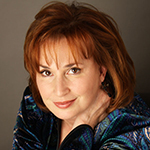Charles Busch
The Lady at the Mic
Lincoln Center’s American Songbook
The Appel Room, NYC, February 26, 2016
Reviewed by Marilyn Lester for Cabaret Scenes
 Charles Busch is a happening, an experience, a package of talent that’s full-bodied entertainment. He’s an accomplished writer and an actor whose métier is drag and who has long professed a deep love for the iconic women of stage and theater. In The Lady at the Mic, Busch, in glamorous costume as one of his many diva personas, pays tribute to five women who have made unique contributions to the world of cabaret, and whom Busch has personally known and admired: Elaine Stritch, Polly Bergen, Mary Cleere Haran, Julie Wilson, and Joan Rivers.
Charles Busch is a happening, an experience, a package of talent that’s full-bodied entertainment. He’s an accomplished writer and an actor whose métier is drag and who has long professed a deep love for the iconic women of stage and theater. In The Lady at the Mic, Busch, in glamorous costume as one of his many diva personas, pays tribute to five women who have made unique contributions to the world of cabaret, and whom Busch has personally known and admired: Elaine Stritch, Polly Bergen, Mary Cleere Haran, Julie Wilson, and Joan Rivers.
The Lady at the Mic is a heartfelt reminiscence through story and song, with a funny and polished narrative. Take Busch’s appraisal of Elaine Stritch: “Five-minutes with her and you have an anecdote to dine out on.” Movingly, Busch sings Sondheim’s “A Parade in Town,” the song that Stritch, ill and about to retire, was determined to master for her last show at the Café Carlyle. Cabaret diva Mary Cleere Haran was a staunch archivist, as Busch pointed out, and the song he chose to most define her is “I’m Old Fashioned.” Julie Wilson, indisputably the crème de la crème of cabaret artists, was not only a prodigious talent, but was fiercely dedicated in her support and mentoring of other performers. Because Wilson was known as a prime interpreter of Sondheim’s music, Busch performed “With So Little to Be Sure Of”/”Too Many Mornings” for her. Polly Bergen, singer and actress who starred in a Busch movie, was represented by “I’m Glad There Is You (In This World of Ordinary People).
” Busch’s most touching tribute was reserved for Joan Rivers, a close friend who, although not a singer, performed her act in many cabaret rooms in New York.
And finally, fittingly, the last lady at the mic was Muriel Passman, the comic and oft-hysterical character from Busch’s hit stage play The Tale of the Allergist’s Wife, who sang her favorite Muppets song, “The Rainbow Connection.” Musical Director and piano man for The Lady at the Mic was Tom Judson, who contributed to the show with additional lyrics for Peter Allen and Carole Bayer Sager’s “Quiet Please, There’s a Lady on Stage,” as well as writing a new song, the eponymous “The Lady at the Mic.” Joe Gallant provided a steady bass while Guy Klucevsek, a master of the accordion, produced sophisticated and sublime sounds not usually associated with this maligned instrument.
The Lady at the Mic was deftly directed by Carl Andress.





